Flatbush Dutch Reformed Church Complex
Introduction
Text-to-speech Audio
The stone church building towering over Flatbush Ave. at the corner with Church Ave. is the third church building that has stood on this site. The Flatbush Dutch Reformed Church building was finished in December 1796 and dedicated in January 1797. The surrounding churchyard burial ground has gravestones dated back to 1754. To the south of the churchyard are two historic outbuildings: the Parish House, constructed in red brick from 1922 to 1924, and the Parsonage, a wood-frame house built in 1853. The Flatbush Dutch Reformed Church building has been on the New York and National Registers of Historic Places since 1983 and is one of the oldest surviving church buildings in New York City. The church and the Parsonage were named New York City landmarks in 1966 and 1979, respectively. The building is still a church, owned by the Reformed Church in America.
Images
2016 view of exterior of Flatbush Dutch Reformed Church, looking northwest across Flatbush Ave. (NYS CRIS)
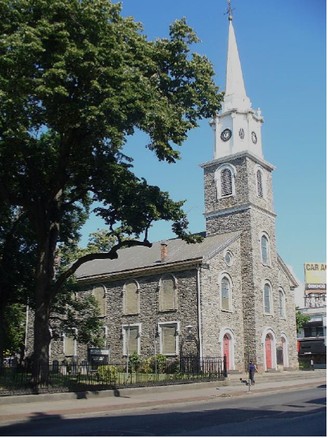
Flatbush D. R. Church in photo in 1901 book on Flatbush (Fisher 1901 p. 37)
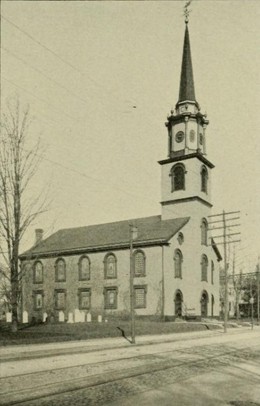
Flatbush D. R. Church (green arrow) with Parsonage to its south on 1890 map (Robinson's Atlas of Kings County, N.Y. p. 2)
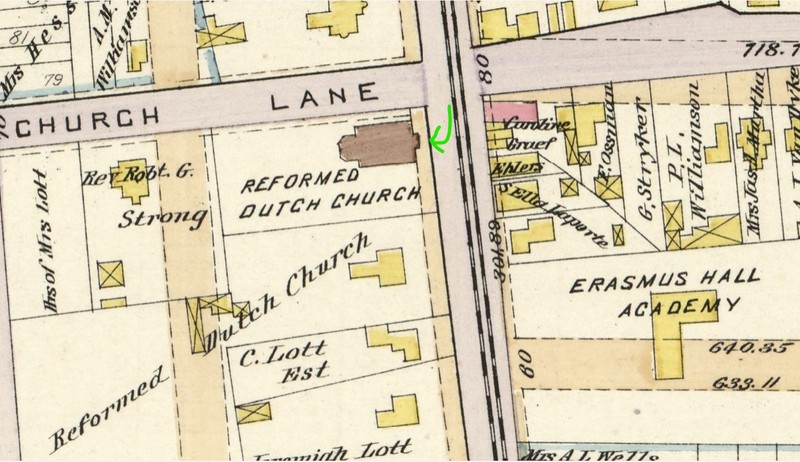
Flatbush D. R. Church Parsonage in ca. 1979 photo (NYC LPC 1979b)
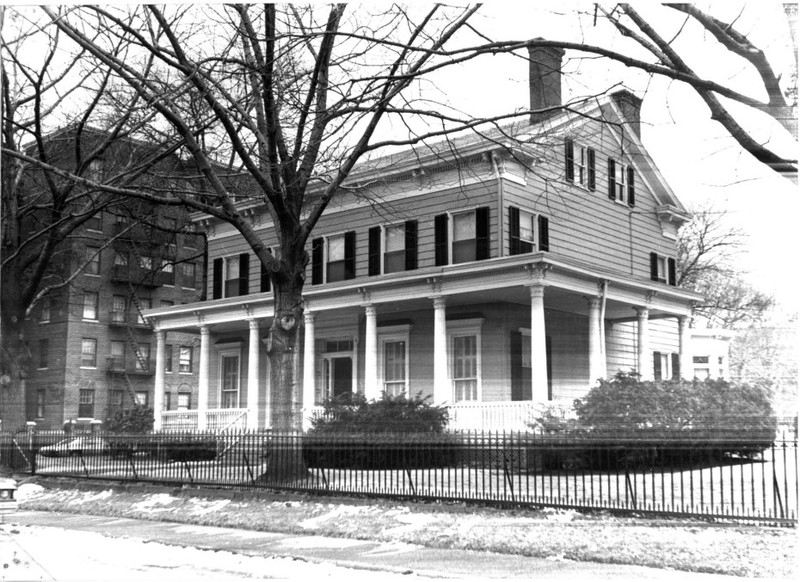
Flatbush D. R. Church Parish House and cemetery in ca. 1979 photo (NYC LPC 1979a)
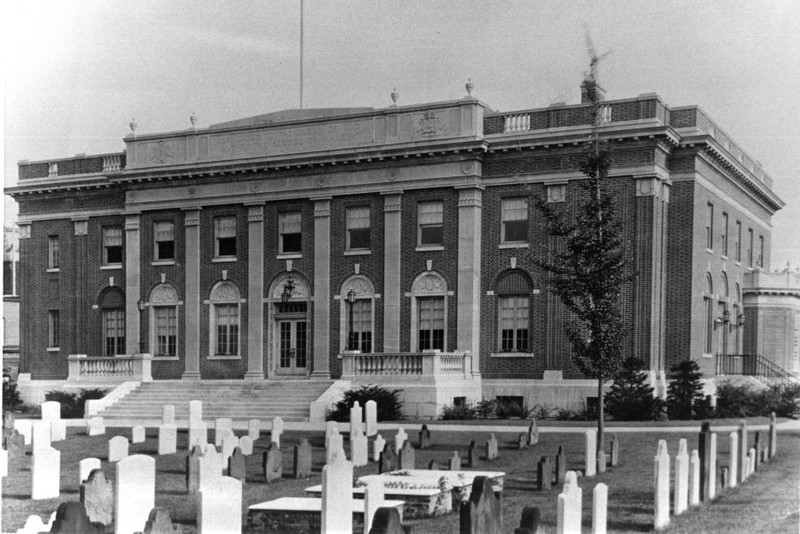
Backstory and Context
Text-to-speech Audio
The Dutch settlement of Flatbush began in the early 1650s and was called Midwout. The first church on the site dated to around 1655! Director Peter Stuyvesant ordered in 1654 that a church be built in the new settlement in the form of a cross, 65 ft. by 25 ft. and 14 ft. high under the beams. The present (third) church was constructed in local stone (grey Manhattan schist) and Holland brick; the bricks surrounding the windows and doors were replaced in the mid-nineteenth century with the present Romanesque-style round-arched lintels. The Federal style building features a tall, square tower topped by an octagonal wooden lantern below carved urns and a spire. The foundation reuses the stone foundation of the second church, built in 1699; the second church was about 65 by 50 ft. with a hipped roof and a small steeple. The second church was demolished to build the new church in the 1790s. When the third church was built, burials under the floor of the prior church were exhumed and reburied in front of the new church. Beginning in 1701, ministers who died had been buried beneath the church, as well as some wealthy parishioners. Some of the soldiers who died in the Revolutionary War Battle of Long Island (aka Battle of Brooklyn) were buried beneath the church in the 1770s. The present (third) church was designed by Thomas Fardon, an architect and master builder, and was finished in December 1796. The building is one of the oldest remaining churches in New York City.
The wood-frame Parsonage to house the church's minister now stands to the southwest of the church at 2101-2103 Kenmore Terrace (a dead-end street off of E. 21st St.). When it was built in 1853, it faced Flatbush Ave. to the south of the church; it was moved to its present location in 1918. This is the church's third parsonage. The former parsonage was built in the early 1820s for Reverend Thomas M. Strong and stood on Flatbush Ave., north of the Erasmus Academy; the building was auctioned off in 1853. Rev. Strong wrote a book detailing the history of Flatbush in 1842; he was still serving the church in 1853 and moved into the new parsonage. Rev. Strong served the parish until his death in 1861. The new parsonage has elements of Greek Revival and Italianate designs. The two-and-a-half story house has four chimneys and a peaked roof. The piazza or porch extends across the whole front and east side of the building and has ten fluted columns with Corinthian capitals. A two-story rear wing contained a kitchen and dining room below servants' quarters.
The two-story, nine-bay-wide Parish House was built in the early 1920s in Colonial Revival style. The red brick building is trimmed in limestone and was designed by Meyers & Mathieu. The building was included in an expansion of the landmarked site for the church by the New York City Landmarks Preservation Commission (LPC) in 1979. In that same year, the LPC designated the Parsonage as an individual landmark.
Sources
Fisher, Edmund D. Flatbush, Past & Present. Brooklyn, NY. Flatbush Trust Company, 1901.
NYC Landmarks Preservation Commission. Landmark Designation Report, Flatbush Dutch Reformed Church Parsonage, LP-0170, 890 Flatbush Avenue, Brooklyn. New York, NY. New York City Government, 1966.
NYC Landmarks Preservation Commission. Landmark Designation Report, Flatbush Dutch Reformed Church, Expanded Landmark Site, LP-0170, 890 Flatbush Avenue, Brooklyn. New York, NY. New York City Government, 1979a.
NYC Landmarks Preservation Commission. Landmark Designation Report, Flatbush Dutch Reformed Church Parsonage, LP-1013, 201-2103 Kenmore Terrace, Brooklyn. New York, NY. New York City Government, 1979b.
Wiggins, Robert L. NYS Historic Trust Survey of Historic Sites and Buildings form, Flatbush Dutch Reformed Church, Brooklyn, N.Y. Albany, NY. New York State, 1968.
New York State Cultural Resource Information System (NYS CRIS): https://cris.parks.ny.gov/Default.aspx
Fisher, Edmund D., Flatbush, Past & Present (Flatbush Trust Company, Brooklyn, NY) 1901
https://www.loc.gov/item/2011594778/
NYC Landmarks Preservation Commission 1979 designation report LP-1013
NYC Landmarks Preservation Commission 1979 landmark expansion report LP-0170
